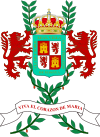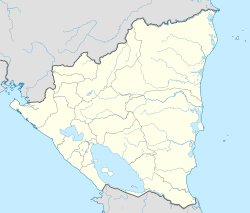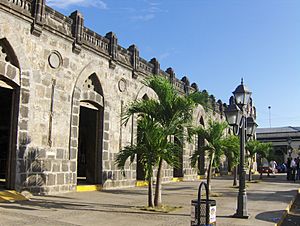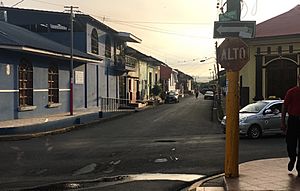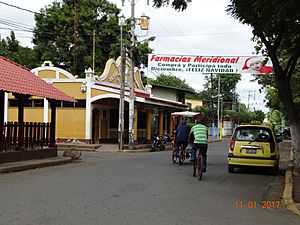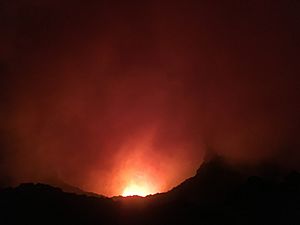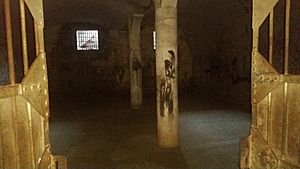Masaya facts for kids
Quick facts for kids
Masaya
|
|||
|---|---|---|---|
|
Municipality
|
|||
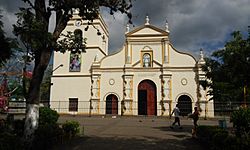
La Asunción church in the Central Park of Masaya
|
|||
|
|||
| Country | Nicaragua | ||
| Department | Masaya Department | ||
| Area | |||
| • Municipality | 57 sq mi (147 km2) | ||
| Population
(2022 estimate)
|
|||
| • Municipality | 191,574 | ||
| • Density | 3,375/sq mi (1,303/km2) | ||
| • Urban | 138,657 (4th Nicaragua) | ||
Masaya is an important city in Nicaragua. It is the capital of the Masaya Department. You can find it about 14 kilometers (9 miles) west of Granada. It is also about 31 kilometers (19 miles) southeast of Managua, the country's capital.
Masaya is located right next to the Masaya Volcano. This is an active volcano that gives the city its name. With over 138,000 people (as of 2022), Masaya is Nicaragua's fourth largest city. It is also known as the "City of Flowers" because of its beauty and culture.
Contents
History of Masaya
Early People and Spanish Arrival
It is believed that the Nicaraos people were the first to live in the Masaya area. The Chorotegas people also lived here. There is proof of their settlements in small towns like Nindiri, Niquinohomo, and Monimbó. This was long before the Spanish arrived.
One of Masaya's main neighborhoods is Monimbó. Its name means "close to the water" in Spanish. It is very near the lagoon. Records show that in the 6th century, Monimbó had about 150 tribes living there.
In 1524, Pedrarias Davila began the Spanish conquest of this area. He created the first encomiendas, which were grants of land and the right to use local labor. Masaya was on the main road connecting Granada to León. It was also on the path to Panama. Because of this, it quickly became a popular resting spot for travelers. Many people chose to settle here due to the nice weather and rich soil. This is how the colonial city of Masaya grew.
Becoming a City
On March 24, 1819, King Ferdinand VII of Spain gave Masaya a special title. He called it "Very Noble and Loyal Village Faithful to San Fernando of Masaya." You can still see this title on the city's coat of arms today. The coat of arms also says, "Long Live the Heart of Mary." Masaya was officially declared a city on September 2, 1839.
Among all the old native settlements, only Monimbó has kept its unique cultural identity.
A Historical Battle
On September 19, 1912, during a civil war in Nicaragua, a battle took place in Masaya. Nicaraguan rebel forces fought against American Marines and sailors. The Americans were passing through the city on their way to Granada. This event is known as the Battle of Masaya.
What Masaya Produces
Masaya is in the middle of a big farming area in Nicaragua. A lot of the crops from the Masaya and Carazo departments pass through Masaya. They then go north to Managua and Leon.
Masaya is also an important place for making things. It is known for producing shoes and clothes. Other industries in the city include making fiber, cigars, leather items, soap, and starch. Many towns around Masaya make furniture from hardwood and wicker. There is even a neighborhood in Masaya, near the lake, that specializes in making hammocks.
Fun Things to See and Do
Masaya is called "The Cradle of Nicaraguan Folklore." It is the main center for Nicaraguan handicrafts.
Masaya Markets
The main market in Masaya is right next to the central bus station. This market is divided into different areas for different types of goods. You can find unique Nicaraguan products here. These include hand-woven hammocks, embroidered blouses, wood carvings, and items made from hemp. The market also sells electronics, clothes, raw meat, hardware, beauty supplies, and fresh produce.
The Mercardo de Artesanias, or Craft Market, is in an old building from the 1900s. It used to be called the "mercado viejo" (old market). This market has been updated and is now a popular spot for tourists. Here, you can find crafts from Masaya and other parts of Nicaragua. Every Thursday night, there is a "Noche de Verbena" or "Night of Revelry." During this event, people perform traditional folkloric dances.
Festivals and Churches
Masaya is famous for its yearly fall festival of San Jerónimo. This festival features traditional dances and street parades. One of these is the "Torovenado" celebration. During this, groups and individuals often perform funny acts that make fun of local and national leaders.
The old city center has open plazas and two large churches from the 16th century. These churches are built in the baroque architecture style. They are the Assumption's Parish Church and St. Gerome's Church. There are also other beautiful old churches like St. John's, St. John Bosco's, and St. Michael's.
Masaya is also the name of one of Nicaragua's Departments. The city of Masaya is its main city. Other cities in the department include Catarina, Nindirí, Masatepe, Tisma, Niquinohomo, Nandasmo, San Juan de Oriente, and La Concepción.
Masaya Volcano National Park
Volcán Masaya National Park is a popular place for tourists. It has a small museum and a place for tourist information. You can find tour guides and special equipment for exploring bat caves. These caves were formed by lava flows from past eruptions. Today, you can often see glowing lava inside the volcano's crater.
Masaya is the most active volcano in this region. It is actually made up of two volcanoes: Masaya and Nindirí. Together, they have five craters. The Spanish first wrote about the volcano in 1524. They thought the lava was melting gold. But when Fray Bartolomé de las Casas saw it, he called it the "Gates of Hell." Since then, Masaya Volcano has erupted at least 19 times. From 1965 to 1979, the volcano had an active lake of lava. The last reported eruption was in 2003. During that event, a plume of ash and gas shot about 4.6 kilometers (2.9 miles) into the air. Masaya is a special type of volcano because it can have explosive eruptions. An eruption around 4550 B.C. was one of the biggest on Earth in the last 10,000 years.
Apoyo Lake
The city of Masaya is also located west of a large, deep lake called "Apoyo." This lake is part of the Apoyo Lagoon Natural Reserve. It is a popular attraction in the area. You can find several hostels and small resorts around it. Apoyo's crater is four miles wide and over 656 feet deep. Fun activities here include fishing, water sports, and scuba diving. Researchers have found signs that people lived around this lake even before the Spanish arrived.
Coyotepe Fortress
Coyotepe is an old fortress located on a steep hill. It is now a museum. It was built around the year 1900 by President José S. Celaya. This place saw a fierce battle from October 2-4, 1912. During this time, a Nicaraguan rebel group led by General Benjamín Zeledón was occupying Coyotepe. They also held another hill that overlooked a key railway line. They refused to give up to the government troops.
Later, the fortress was used as a place to hold prisoners during times of trouble. In the 1960s, a President Somoza ordered it to be given to the Boy Scouts Organization. For many years, Coyotepe was a military outpost. By the 1970s, it was given to the Boy Scouts Association. The fortress has 43 jail cells. Twenty-eight of these are on the upper floor. These cells have windows that let in air and sunlight. Each upper cell could hold many prisoners. The cells in the basement were very different. They were dark, damp, and cramped. Prisoners there could easily lose track of time. In its early years, about 1,000 prisoners could be held there at once.
The Boy Scout Association stopped using the site from 1983 to 1992. After 1990, new governments returned Coyotepe to the Boy Scouts Association.
Delicious Food in Masaya
Masaya has many traditional foods based on old recipes.
- Nacatamal is a large tamal. It is made from corn flour mixed with pork, bacon, rice, potatoes, onions, tomatoes, and peppers. It also has mint, chili, and prunes. All of this is wrapped in plantain leaves, tied up, and boiled for a few hours. People usually eat Nacatamals for breakfast or supper with bread and coffee.
- Vaho is another hearty meal. It is usually eaten for lunch. It is made with thick slices of salted, dried beef marinated in sour orange juice. The beef is mixed with yucca, green plantains, ripe plantains, tomatoes, onions, garlic, and cabbage. This mixture is placed in a pot lined with plantain leaves. Then it is covered and slowly steamed. Vaho is eaten with tortillas.
- Yucca is a root vegetable that is very important in Masayan food. It can be boiled, steamed, fried, or broiled. It is used in many dishes, like vigorón.
- Vigorón is made with boiled yucca. It is topped with a sweet-and-sour cabbage salad. This salad has cabbage strips, diced tomatoes, onions, green currants, chili, vinegar, and salt.
Famous People from Masaya
- Enrique Bolaños, a former president of Nicaragua
- Olga Núñez Abaunza, Nicaragua's first female lawyer
Sister Cities
Masaya has friendly connections with these cities around the world:
 Belo Horizonte, Brazil
Belo Horizonte, Brazil Cartago, Costa Rica
Cartago, Costa Rica Dietzenbach, Germany
Dietzenbach, Germany Leicester, England, United Kingdom
Leicester, England, United Kingdom Nijmegen, Netherlands
Nijmegen, Netherlands
Images for kids
See also
 In Spanish: Masaya para niños
In Spanish: Masaya para niños



